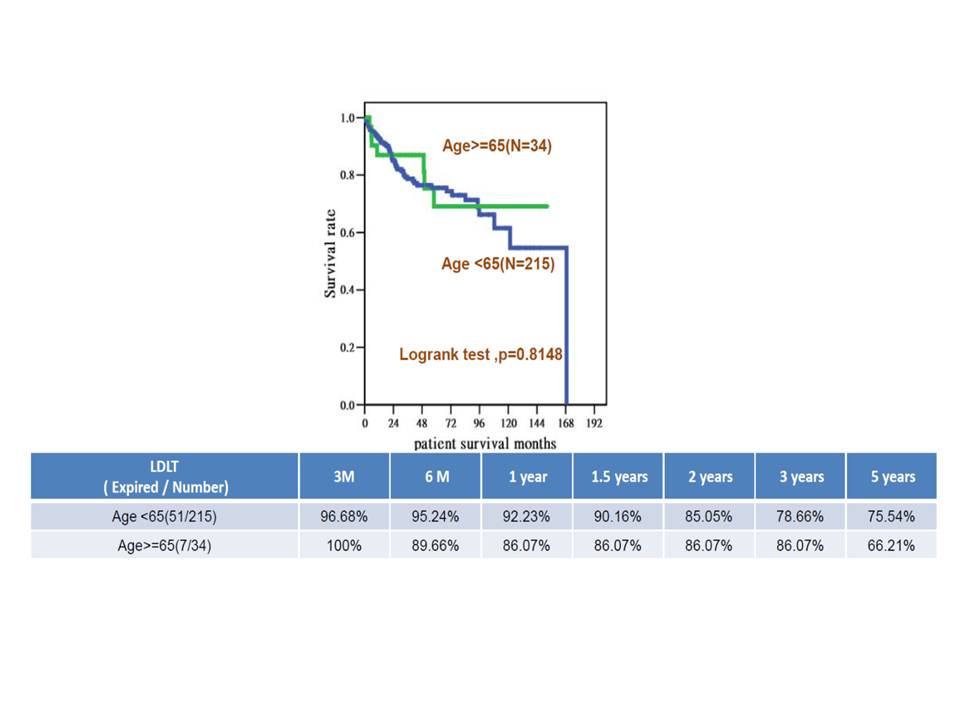Outcome Of Living Donor Liver Transplantation In Elderly Patients >65 Years With And Without Hepatocellular Carcinomas: A Retroepsective Analysis
A. Thorat, L. Jeng, S. Hsu, H. Yang, C. Yeh, T. Chen, K. Poon, P. Li
Organ Transplantation Center, China Medical University Hospital, Taichung, Taiwan
Meeting: 2019 American Transplant Congress
Abstract number: D120
Keywords: Hepatocellular carcinoma, Living-related liver donors
Session Information
Session Name: Poster Session D: Liver: Hepatocellular Carcinoma and Other Malignancies
Session Type: Poster Session
Date: Tuesday, June 4, 2019
Session Time: 6:00pm-7:00pm
 Presentation Time: 6:00pm-7:00pm
Presentation Time: 6:00pm-7:00pm
Location: Hall C & D
*Purpose: The elderly patients > 65 years with end-stage liver disease that require liver transplantation has been steadily increased over last decade in Taiwan and throughout the world. However, as advanced patient age isprone for higher risks of infection and other cardiovascular morbidities that can become life‐threatening after transplantation, the allocation of deceased organ to elderly patients remained a controversial topic. The living donor liver transplantation (LDLT) in elderly patients raises the ethical issues of the procedure due to associated surgical risk for healthy living liver donors. This study reviews our experience of LDLT in elderly patients >65 years. We also aim to analyze the outcome of LDLT in this patient population with and without hepatocellular carcinoma (HCC).
*Methods: From 10 September 2002 to 31 October 2018, a total of 957 LDLT surgeries were performed at China Medical University Hospital, Taiwan. The database was analyzed for elderly patients >65 years at the time of LDLT (Group A, n=101) and the outcome of LDLT was compared to younger group (Group B, n=854). In group A, 44 patients were diagnosed to have HCC whereas 57 patients underwent LDLT for non-malignant cause.
*Results: The study cohort comprised of 101 patients (HCC-57, Non-HCC-44). The mean age was 67 ± 2.5 years (range,65 to 75 years). Overall 5-year survival of group A was 72.54% whereas for the group B it was 74.34%. The subgroup of HCC patients (n=57) comprised of 34 (59.6%) patients within UCSF criteria whereas 23 (40.35%) patients were beyond criteria.For group B, similar HCC subgroup (n=384) comprised 215 patients (55.98%) within UCSF criteria whereas 169 patients (40.01%) were beyond UCSF criteria. A 3 & 5-year survival of group A patients within UCSF criteria was 86.07% & 66.21%, respectively whereas for group B it was 78.66% & 75.54%, respectively (Figure 1).
*Conclusions: This retrospective analysis highlights the comparable outcome after LDLT in elderly patients >65 years. The elderly patients with HCC have superior 3-year survival as compared to patients <65years of age. This experience shows the feasibility and safety of LDLT in elderly patient population and should not be excluded from LT solely based on age. However, careful selection process must be followed and associated comorbidities that may contraindicate the LDLT should be evaluated.
To cite this abstract in AMA style:
Thorat A, Jeng L, Hsu S, Yang H, Yeh C, Chen T, Poon K, Li P. Outcome Of Living Donor Liver Transplantation In Elderly Patients >65 Years With And Without Hepatocellular Carcinomas: A Retroepsective Analysis [abstract]. Am J Transplant. 2019; 19 (suppl 3). https://atcmeetingabstracts.com/abstract/outcome-of-living-donor-liver-transplantation-in-elderly-patients-65-years-with-and-without-hepatocellular-carcinomas-a-retroepsective-analysis/. Accessed December 16, 2025.« Back to 2019 American Transplant Congress

